A fence is not only a protective structure, but in many cases the final element of the overall architectural ensemble of a house or cottage. As a rule, the basis of the fence is made up of pillars, which can be made of metal, concrete or wood. The durability and reliability of the structure is determined by the technology of their installation.
- Requirements for fence posts and installation technology
- The choice of material for the supports of the fence
- Steel pillars
- Asbestos cement pipes
- Wooden pillars
- Concrete pillars
- Concreting methods
- Dry concreting
- Spot concreting
- Partial concreting
- Complete concreting
- How to concrete fence posts yourself
- Markup
- Drilling
- Preparation of mortar and installation of supports
- Reinforcement
- Concrete pouring and air removal
Requirements for fence posts and installation technology

The main requirement for fence posts is durability. During operation, they must withstand the mass of the spans and be resistant to dynamic loads. When designing a fence, it is necessary to provide a margin of safety so that it can withstand strong gusts of wind.
The choice of technology for installing fence supports is determined by the characteristics of the soil on the site. The reliability of the structure of the fence depends on the depth of freezing of the soil and the level of occurrence of underground waters.
- It is not recommended to concrete pillars installed in heaving soil.
- On hard soils, it is better to hammer in the supports.
- The pillars are concreted in areas with sandy-clay or sandy soil.
When arranging massive barriers, support pillars must always be concreted.
The choice of material for fence supports

As supports for the fence, you can use:
- wooden posts;
- steel tubes;
- concrete supports;
- asbestos-cement pipes.
Steel pillars
Steel pillars are most in demand when erecting fences. They have excellent strength and performance characteristics. Supports made of stainless steel are especially reliable, the service life of which can exceed 50 years. However, such pipes are quite expensive and not every landowner can afford to use them.
Asbestos cement pipes
Asbestos-cement pipes are used as supports for fences quite often. They have the following advantages:
- perfect geometric shape;
- high strength;
- durability - the pillars are not subject to decay.
However, asbestos-cement pillars are very fragile and require attention during installation. To strengthen their internal cavities, it is recommended to fill them with concrete. To mount the lag, you will need to make special brackets and long hairpins.
Pipes made of asbestos cement must be protected from water ingress after installation, since frozen moisture can destroy them in winter.
Wooden pillars

For the manufacture of pillars from wood, a bar is traditionally used, which has a rectangular or square cross-section, as well as rounded logs. Coniferous wooden poles are inexpensive, therefore they are often used as supports for fences. To exclude their rotting, the lower part of the post must be treated with an anti-corrosion compound. The main disadvantage of such supports is their short service life (no more than 3 years). Oak pillars can last for more than a dozen years, but the high price significantly limits their use as fence supports.
Concrete pillars
Concrete poles are a good alternative to metal supports and wooden beams. They are made from a special solution based on M-400 cement. The prepared solution is poured into a box-shaped formwork, in which there is a reinforcing frame. The outer surface of such pillars is covered with a special primer or decorative paint. Structurally, concrete pillars can be:
- monolithic;
- composite.
Monolithic supports are much stronger than composite ones and retain their integrity when exposed to heavy loads. They are used when installing massive fences.
Concreting methods

Concreting fence posts is the main method of installation. Driving in pillars is used, as a rule, only when installing temporary fences. There are several methods of concreting:
- dry;
- point;
- partial;
- complete.
Wooden poles are not subjected to concreting. They are inserted into concrete pipes made of metal or asbestos cement.
Dry concreting
The dry method of installing pillars (bucking) is carried out as follows:
- Wells are drilled in the ground, the diameter of which is twice the diameter (section) of the support.
- A waterproofing material, for example, roofing felt, is placed in the prepared well.
- A support is inserted into the middle of the rolled tube.
- The free space between the waterproofing material and the support surface is filled with a sand-crushed stone or sand-gravel mixture.
- The poured mixture is constantly poured with water and thoroughly rammed.
When filling the well with rubble mixture, it is necessary to constantly monitor the vertical position of the column.
Spot concreting

Spot concreting is used when the maximum freezing depth of the soil reaches 1.3 m, and the groundwater level is 1.5 m.A well 1.4 m deep is drilled in the soil, it is advisable to use a drill that ensures the expansion of the well in its bottom part (anchor expansion ). At the bottom of the well, a sand cushion with a thickness of at least 0.3 m is arranged and a protective sleeve made of roofing material is inserted. Then a pillar is driven into this sleeve and, using a level, it is set vertically. At the final stage, concrete is poured into the well with an admixture of broken brick and crushed stone.
Anchor expansion prevents the support from being pushed out when the soil heaves due to uneven freezing and thawing of the soil.
Partial concreting
The partial concreting method differs from the dry method in that the prepared well is filled with rubble mixture or excavated soil up to half. After the mixture is well compacted, the rest of the well is poured with concrete to ground level.
Complete concreting
With full concreting, a waterproof cushion made of a mixture of sand, crushed stone and gravel is placed on the bottom of the prepared well. Then a pillar is installed on it, after which the well is completely filled with concrete.
How to concrete fence posts yourself

Having decided on the technology for installing supports for the fence, the landowner can begin to carry out preparatory work. At the first stage, you need to thoroughly clean the site from debris and unnecessary items. All plants and structures that interfere with the arrangement of the fence are removed.
Markup
Having completed the clearing and subsequent leveling (if possible) of the territory, they begin to mark the perimeter of the site, along which the fence will be installed. It is done with pegs and a long rope. Having determined the location of the fence posts, they are marked with pegs, which are driven into the ground with a sledgehammer. Typically, the spacing between the supports is 2 to 3 meters. The rope stretched between the pegs will allow you to correctly orient the support posts of the fence in a straight line.
Drilling
Drilling is one of the most time consuming operations in preparing wells for the installation of supports.This procedure is carried out using a walk-behind drill or a hand-held garden drill. Work with a hand drill increases the labor intensity and construction time many times over.
The important drilling parameters are the depth and shape of the drilled wells. Most often, cylindrical wells are drilled with a depth of 1.2-1.3 m. At a low groundwater level, wells can be shallower.
Preparation of mortar and installation of supports

To fill the supports in the wells, it is necessary to prepare a concrete solution:
- Portland cement grade M-400 and above - 1 part;
- sand - 2-3 parts;
- gravel or crushed stone - 3-4 parts;
- water - 0.5-1.0 part.
All ingredients must be thoroughly mixed, water is served in small portions.
To prepare a high-quality solution, it is necessary to check the expiration date of the cement (expired cement is not suitable), all other components must be thoroughly washed and sieved - the presence of small debris, inclusions of clay, soil and other debris is not allowed.
The supports are installed on a drainage pad, which, as a rule, consists of sand and a layer of fine gravel. Before you start pouring the supports, they must be leveled.
Reinforcement

The service life and strength of the fence can be increased by additionally installing a reinforcing structure made of steel rods into the pit and inserting a rolled roofing material inside the well.
The reinforcing frame will give the pillars additional strength, and the roofing material wrapped around the pillar will protect the support from the forces of frost heaving - the soil will slide over the roofing material, and the support pillar will remain in place.
Concrete pouring and air removal
The concrete is poured into the pit immediately after preparation. The fill must be done in one go. A homogeneous concrete monolith will be obtained only if air is removed from the concrete during pouring. For this, bayonetting is used: with strong vertical movements, a piece of reinforcement is driven in to the entire depth of the well and then the entire filling is carried out with small swaying.
The use of a drill or hammer drill equipped with a special vibration nozzle will help to facilitate the bayonet process.
After removing all the air, it is necessary to allow time for the solution to completely solidify. As a rule, concrete hardens for 3-4 weeks, after which you can mount the rest of the fence elements on the supports.









they will be sticking out with frost, it is necessary to coat them and hammer them right in